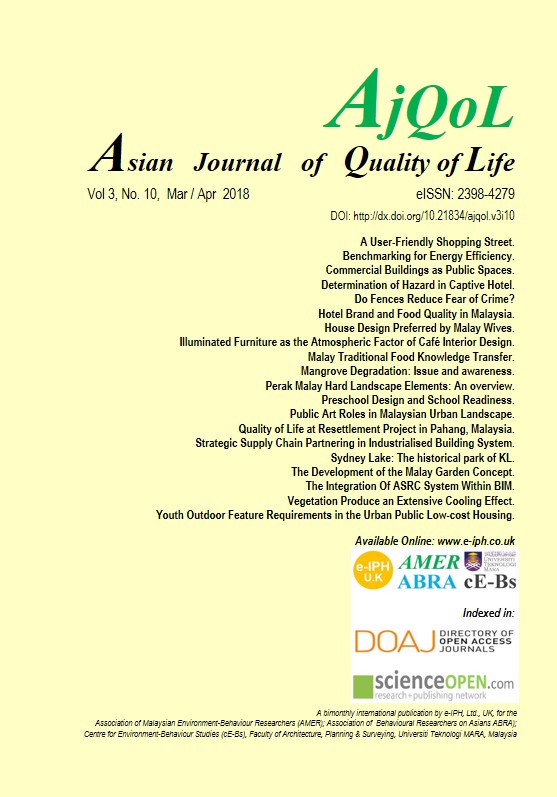The Development of the Malay Garden Concept
Main Article Content
Abstract
This study discusses the development of the Malay garden concept using the old Malay manuscripts and site observation to the Malay villages along Peninsular Malaysia. The inherited landscape design concept can offer as a guideline to conserve the integrity and the authenticity of the traditional Malay garden design and the strength of these characters will extensively use in developing the concept of landscape design in Malaysia due to the increasing awareness of design and the quality of life.
Metrics
Article Details
License
Copyright (c) 2018 Ismail Hafiz Salleh, Mohd Sabrizaa Abd. Rashid, Siti Rasidah Md Sakip, Mohammad Rusdi Mohd Nasir

This work is licensed under a Creative Commons Attribution-NonCommercial-NoDerivatives 4.0 International License.
References
Abdul Rahman Al-Ahmadi (2003). Tamadun Rumpun budaya Melayu, Kementerian Kebudayaan, Kesenian dan Pelancongan Malaysia.
Abdullah Sani Ahmad, Jamil Abu Bakar & Fawazul Khair Ibrahim (2006). Kajian elemen rekabentuk landskap Melayu, nilai fungsi komponen dalam landskap Melayu, Universiti Teknologi Malaysia.
Ahmad Zamil Zakaria, Ismail Hafiz Salleh & Mohd Sabrizaa Abdul Rashid (2014). Identity of Malay garden design to be promoted as the cultural tourism product in Malaysia. Procedia - Social and Behavioral Sciences Vol. 153 (2014) 298–307, Elsevier Ltd. DOI: https://doi.org/10.1016/j.sbspro.2014.10.063
Ahmad Zamil Zakaria, Ismail Hafiz Salleh & Mohd Sabrizaa Abdul Rashid (2012). Landscape furniture present in the ancient Malay garden according to old manuscripts and their effects on the formation of Malay garden design concept model in Malaysia, PSU - USM International Conference on Art and Sciences, Procedia - Social and Behavioral Sciences Vol. 91 (2013) 28 - 35, Elsevier Ltd. DOI: https://doi.org/10.1016/j.sbspro.2013.08.397
Anisa Ani, Noorizan Mohamed & Nordin Abul Rahman (2012). Socio-cultural influences in the composition of traditional Malay house compounds in rural Melaka. Alam Cipta, International Journal of Sustainable Tropical Design Research and Practice Vol. 5 No 1 (2012) 63 – 78.
Bambang, S., Budi, S., & Hermin, W. (2012). In search of the power of javanese culture against the cultural urbanization in Kotagede, Yogyakarta-Indonesia, AicE-BS 2012 Cairo, Procedia - Social and Behavioral Sciences Vol. 68 (2012) 676 - 686, Elsevier Ltd. DOI: https://doi.org/10.1016/j.sbspro.2012.12.258
Ismail, N.A. & Said. I. (2002). Design paradigm: Sustaining responsive cultural landscape of Malay rural residential area. Proceeding of Second International Seminar on Vernacular Settlement. 316-323.
J.W.R. Whitehanda, Kai Gub (2007). Conserving urban landscape heritage: A geographical approach. Procedia - Social and Behavioral Science Vol. 2, Issue 5 (2010) 6948–6953. Elsevier Ltd. DOI: https://doi.org/10.1016/j.sbspro.2010.05.047
Malay Concordance Project. Retrieved October 2014 from http://mcp.anu.edu.au/Q/mcp.html
Mohamad Tajuddin Mohamad Rasdi (2005). Malaysia Architecture: Crisis Within, Utusan Publication & Distributors Sdn. Bhd ISBN 967-61-1728-5.
Mohammad Rusdi Mohd Nasir (2012). A study of the Kelantan Malay cultural landscape: Recent trends and future prospects, (PhD research), University of Sheffield.
Noor Hanita, A.M., Hokoi, S. & Nozomi, T. (2012). Vernacular wisdom: The basis of formulating compatible living environment in Oman. AicE-BS 2012 Cairo, Procedia - Social and Behavioral Sciences Vol. 68 (2012) 637 - 648, Elsevier Ltd. DOI: https://doi.org/10.1016/j.sbspro.2012.12.255
Ismail, N.A. & Said. I. (2001). Cultural-ethnic landscape of terrace housing community in Peninsular Malaysia. Journal of Technology B (35B), 1-27.
Shuhana Shamsuddina, Ahmad Bashri Sulaimana & Rohayah Che Amatb (2012). Urban landscape factors that influenced the character of George Town, Penang Unesco World Heritage Site. Procedia - Social and Behavioral Sciences Vol. 50 (2012) 238–253, Elsevier Ltd. DOI: https://doi.org/10.1016/j.sbspro.2012.08.031
Watson, G. B. & Bentley, I. (2007). Identity by Design, 1st ed. Oxford: Architectural Press. DOI: https://doi.org/10.4324/9780080489025




